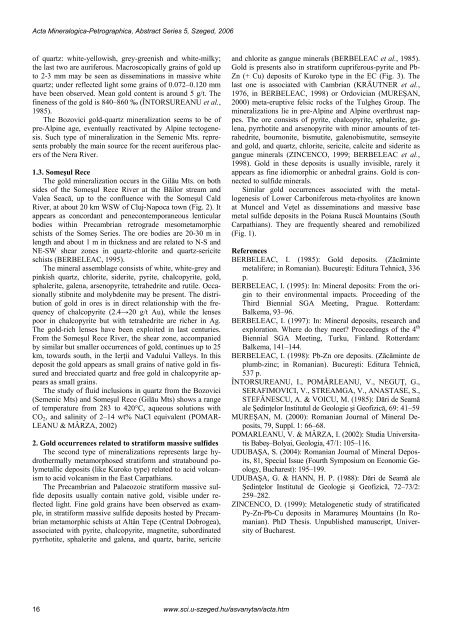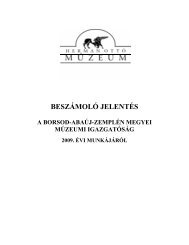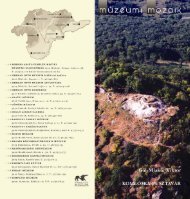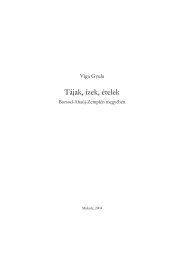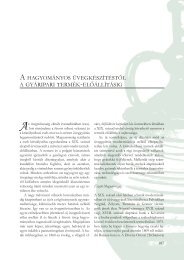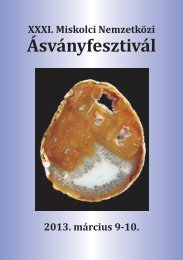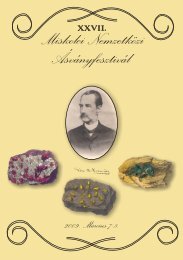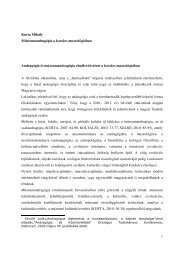MSCC3 3rd MINERAL SCIENCES IN THE CARPATHIANS ...
MSCC3 3rd MINERAL SCIENCES IN THE CARPATHIANS ...
MSCC3 3rd MINERAL SCIENCES IN THE CARPATHIANS ...
Create successful ePaper yourself
Turn your PDF publications into a flip-book with our unique Google optimized e-Paper software.
Acta Mineralogica-Petrographica, Abstract Series 5, Szeged, 2006of quartz: white-yellowish, grey-greenish and white-milky;the last two are auriferous. Macroscopically grains of gold upto 2-3 mm may be seen as disseminations in massive whitequartz; under reflected light some grains of 0.072–0.120 mmhave been observed. Mean gold content is around 5 g/t. Thefineness of the gold is 840–860 ‰ (ÎNTORSUREANU et al.,1985).The Bozovici gold-quartz mineralization seems to be ofpre-Alpine age, eventually reactivated by Alpine tectogenesis.Such type of mineralization in the Semenic Mts. representsprobably the main source for the recent auriferous placersof the Nera River.1.3. Someşul ReceThe gold mineralization occurs in the Gilău Mts. on bothsides of the Someşul Rece River at the Băilor stream andValea Seacă, up to the confluence with the Someşul CaldRiver, at about 20 km WSW of Cluj-Napoca town (Fig. 2). Itappears as concordant and penecontemporaneous lenticularbodies within Precambrian retrograde mesometamorphicschists of the Someş Series. The ore bodies are 20-30 m inlength and about 1 m in thickness and are related to N-S andNE-SW shear zones in quartz-chlorite and quartz-sericiteschists (BERBELEAC, 1995).The mineral assemblage consists of white, white-grey andpinkish quartz, chlorite, siderite, pyrite, chalcopyrite, gold,sphalerite, galena, arsenopyrite, tetrahedrite and rutile. Occasionallystibnite and molybdenite may be present. The distributionof gold in ores is in direct relationship with the frequencyof chalcopyrite (2.4→20 g/t Au), while the lensespoor in chalcopyrite but with tetrahedrite are richer in Ag.The gold-rich lenses have been exploited in last centuries.From the Someşul Rece River, the shear zone, accompaniedby similar but smaller occurrences of gold, continues up to 25km, towards south, in the Ierţii and Vadului Valleys. In thisdeposit the gold appears as small grains of native gold in fissuredand brecciated quartz and free gold in chalcopyrite appearsas small grains.The study of fluid inclusions in quartz from the Bozovici(Semenic Mts) and Someşul Rece (Gilău Mts) shows a rangeof temperature from 283 to 420°C, aqueous solutions withCO 2 , and salinity of 2–14 wt% NaCl equivalent (POMAR-LEANU & MÂRZA, 2002)2. Gold occurrences related to stratiform massive sulfidesThe second type of mineralizations represents large hydrothermallymetamorphosed stratiform and stratabound polymetallicdeposits (like Kuroko type) related to acid volcanismto acid volcanism in the East Carpathians.The Precambrian and Palaeozoic stratiform massive sulfidedeposits usually contain native gold, visible under reflectedlight. Fine gold grains have been observed as example,in stratiform massive sulfide deposits hosted by Precambrianmetamorphic schists at Altân Tepe (Central Dobrogea),associated with pyrite, chalcopyrite, magnetite, subordinatedpyrrhotite, sphalerite and galena, and quartz, barite, sericiteand chlorite as gangue minerals (BERBELEAC et al., 1985).Gold is presents also in stratiform cupriferous-pyrite and Pb-Zn (+ Cu) deposits of Kuroko type in the EC (Fig. 3). Thelast one is associated with Cambrian (KRÄUTNER et al.,1976, in BERBELEAC, 1998) or Ordovician (MUREŞAN,2000) meta-eruptive felsic rocks of the Tulgheş Group. Themineralizations lie in pre-Alpine and Alpine overthrust nappes.The ore consists of pyrite, chalcopyrite, sphalerite, galena,pyrrhotite and arsenopyrite with minor amounts of tetrahedrite,bournonite, bismutite, galenobismutite, semseyiteand gold, and quartz, chlorite, sericite, calcite and siderite asgangue minerals (Z<strong>IN</strong>CENCO, 1999; BERBELEAC et al.,1998). Gold in these deposits is usually invisible, rarely itappears as fine idiomorphic or anhedral grains. Gold is connectedto sulfide minerals.Similar gold occurrences associated with the metallogenesisof Lower Carboniferous meta-rhyolites are knownat Muncel and Veţel as disseminations and massive basemetal sulfide deposits in the Poiana Ruscă Mountains (SouthCarpathians). They are frequently sheared and remobilized(Fig. 1).ReferencesBERBELEAC, I. (1985): Gold deposits. (Zăcămintemetalifere; in Romanian). Bucureşti: Editura Tehnică, 336p.BERBELEAC, I. (1995): In: Mineral deposits: From the originto their environmental impacts. Proceeding of theThird Biennial SGA Meeting, Prague. Rotterdam:Balkema, 93–96.BERBELEAC, I. (1997): In: Mineral deposits, research andexploration. Where do they meet? Proceedings of the 4 thBiennial SGA Meeting, Turku, Finland. Rotterdam:Balkema, 141–144.BERBELEAC, I. (1998): Pb-Zn ore deposits. (Zăcăminte deplumb-zinc; in Romanian). Bucureşti: Editura Tehnică,537 p.ÎNTORSUREANU, I., POMÂRLEANU, V., NEGUŢ, G.,SERAFIMOVICI, V., STREAMGA, V., ANASTASE, S.,STEFĂNESCU, A. & VOICU, M. (1985): Dări de Seamăale Şedinţelor Institutul de Geologie şi Geofizică, 69: 41–59MUREŞAN, M. (2000): Romanian Journal of Mineral Deposits,79, Suppl. 1: 66–68.POMARLEANU, V. & MÂRZA, I. (2002): Studia UniversitatisBabeş–Bolyai, Geologia, 47/1: 105–116.UDUBAŞA, S. (2004): Romanian Journal of Mineral Deposits,81, Special Issue (Fourth Symposium on Economic Geology,Bucharest): 195–199.UDUBAŞA, G. & HANN, H. P. (1988): Dări de Seamă aleŞedinţelor Institutul de Geologie şi Geofizică, 72–73/2:259–282.Z<strong>IN</strong>CENCO, D. (1999): Metalogenetic study of stratificatedPy-Zn-Pb-Cu deposits in Maramureş Mountains (In Romanian).PhD Thesis. Unpublished manuscript, Universityof Bucharest.16www.sci.u-szeged.hu/asvanytan/acta.htm


